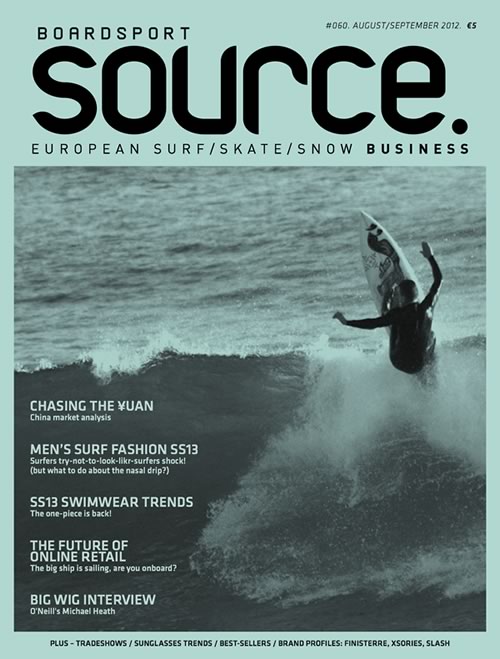
欧洲的板累运动产业媒体Boardsports Source在今年冬天ISPO北京期间来到北京,通过对参展的厂商,媒体,零售商的采访撰写了一份关于中国板类运动市场调查分析的文章.特别翻译成中文来供大家参考.
European Surf, Skate, Snow Business media Boardsports Source came to Beijing this winter during the ISPO Beijing 2012 and put together these analysis as this article blow "Boardsports In China Market Update".
中国板类运动市场即将升级
文:Miriam Deller and Clive Ripley
在ISPO BEIJING展会期间,SOURCE有幸与不少中国板类运动市场重要成员进行了访谈,对象既包括世界领先的品牌也有一些国内厂商,访谈了解了它们对目前市场现状的看法和未来走向。
可以肯定的是,小心翼翼摸索的阶段已经过去。现在,大多数品牌都已经渡过了学习阶段,并开始采用更为复杂的方式接触对板类运动感兴趣的年轻人。
冲浪
杭州新石巨组织了大量冲浪主题展览和活动,推广极限运动及相关生活方式和产品,建立认同感。“杭州冲浪嘉年华和钱塘弄潮活动给我们带来了主流媒体的关注,它们一般是不会注意到极限运动活动的。但这两次活动给我们带来了很高的关注度,并且获得了持续参与。”
冲浪方面另一个重要的活动是Brendan Sheridan组织的海南国际冲浪公开赛。他来自加里福利亚,目前已经在中国生活了12年,4年在香港,8年在中国大陆。2006年他移居三亚,并于2007年秋开始组织海南国际冲浪公开赛。“感觉这里的冲浪发展是一个很自然的过程。2005年海南就有过一次冲浪比赛。我们第一次比赛的运动员都是很草根的业余选手。这么多年来最大的变化是中国冲浪选手增多了。2007年只有一位中国选手参赛,而去年的35位选手中有15个来自中国。”Sherdian和他的团队还在继续组织海南国际冲浪公开赛。在当地政府扶持下,他正在日月湾培训8名中国少年,以帮助冲浪运动在这里发展。
滑板
说到滑板,耐克在中国拥有很强的产品优势,它们一直在向中国消费者提供专供产品。“我们会不时向中国市场供应专为本国生产的产品,以激励这里的消费者。从10年前在中国首次推出Nike SB系列开始,我们已经和著名的专业滑板店Fly Streetwear有过好几次合作。中国消费者喜欢有故事的产品,”耐克大中国区女性运动品牌总监Maggie Wu说。KickerClub.com是中国板类运动最著名的网站。针对目前的中国板类市场,经营者Andrew Guan说道:“有越来越多的重量级公司加入了这个市场,比如耐克、匡威、VANS和其他一些运动品牌。今年开始,一些本土消费品牌也在开始关注板类运动,甚至有饮料品牌也加入进来。滑板周边业务的发展非常迅速——但针对滑板本身而言,我们还得耐心点,给它时间发展。我希望越来越多的年轻人加入进来,而不是买了衣服鞋子却站在一边看。”
单板滑雪
就单板滑雪而言,Burton的亚洲区市场经理Ivar Fougstedt无疑走在最前沿。“Burton品牌在全世界的定位和品牌形象都是一致的,在中国也是一样。主要的区别在于目前单板所处的发展阶段,在这里它还很稚嫩但发展很稳定,所以作为品牌我们必须适应,不能简单照搬在其他成熟市场里的模式。我们组织了大量地方性的草根活动,希望带动整个市场。”
在中国要说单板滑雪就不能不提到Air & Style 沸雪北京世界单板滑雪赛。它吸引了世界顶尖选手的参与,在中国掀起了不小的波澜。但尽管Air & Style带来了专业选手,并成为他们炫耀技巧,震撼观众的平台,能让普通人实际享受单板滑雪的地方还是世界单板滑雪日(WSD)活动。作为中国单板滑雪界的先锋,王磊的核心力量公司为世界单板滑雪日提供赞助。他谈到该活动对这一发展中市场的重要性时说:“世界单板滑雪日带来了很多推广该项目的机会。比如滑雪场就可以试着做一个比较好的活动,邀请各个不同俱乐部的选手,再联合支持这个项目的品牌,就能为希望尝试这项运动的人们创造机会。”
消费者
Protest中国代理商博特斯贸易有限公司的总经理Jack Yang对中国消费者的认识很深刻:“中国国内消费者还处在对西方运动文化的学习过程中,同时市场也在萌发自己独特的运动文化。相比欧洲和北美等成熟市场,中国消费者更加多样化。如何向这样的目标群体宣传自己的市场活动以及媒体渠道的选择都非常重要。这个市场发展的确很快,但同时这里的竞争也比很多人想象的要激烈。专注和精确的定位是市场活动和品牌取胜的关键。”
零售
Jack Yang分享了他对品牌如何在零售业获得成功方面的心得:“品牌定位是它的DNA。品牌成功是有原因的,这不可改变。但是,进入不同的市场时还是应该有所调整。在中国这一点尤其重要,从很多方面来说,中国不应该被视作一个整体的市场,而应该是多个地方市场的集合,在各地都具有不同的行为方式、偏好和条件。”来自S3的Glenn Brumage介绍了他在零售方面的想法:“目前相当困难,尽管有一些增长,但整个体系很不一样。这里占主导的是经营单品牌的专卖店,零售渠道非常稀缺。”他认为一旦多品牌极限运动店开始出现,情况就会好转。
本地合作伙伴
对品牌来说,进入一个基本价值体系完全不同的市场永远是很大的挑战。正确的市场评估和当地合作伙伴是成功的关键。大多数品牌代理都是通过当地伙伴完成,它们往往希望手头有一大批国际品牌,而且互相之间是竞争关系。这对代理企业来说比较理想,他们也不希望有哪个品牌过于强势,因此一般来说即便品牌希望能施展拳脚,它们也受到当地代理商的限制。这让多数品牌陷入一种僵局,很少有品牌能够找到好的机会,因此它们非常需要兴趣方向与自己一致的合作伙伴。
展会
ISPO在中国已经活跃好几年,并拥有中国最重要的运动展会ISPO BEIJING。作为ISPO全球展会的一部分,ISPO BEIJING的组织者很多也同时负责ISPO MUNICH展会。国际品牌因此对在北京展出也充满信息,因为这是一个可以信任的平台,能给他们进入中国市场带来更值得信赖的第一步。2012年的ISPO BEIJING共有353家展商(+28%)和516个品牌(+47%)参展,使用展览面积35,000 m² (+ 17%)。ISPO一直在鼓励板类运动品牌参加,积极推动极限运动在中国的发展。展会最醒目位置设置有极限运动专区,专业滑板场地广受专业选手和爱好者的追捧。展会期间的ISPO滑板公开赛,让众多运动零售商感受了这种运动的魅力。ISPO的海外品牌代理洽谈(Distributor Match Making)专区,让国际品牌与中国经销商可以互相结识。同时,2012年展会还首次组织了On-snow Demo雪地测试活动。Burton总裁Donna Carpenter评价说:“中国的市场需求增长迅速,因此展现品牌历史非常重要。ISPO是值得信任的伙伴,因此我们选择了这里向中国消费者和行业介绍Burton的历史。”
未来
关于未来,中国市场毫无疑问地即将腾飞。S3的Glenn Brumage说道:“通过所有在华品牌的共同努力,现在零售行业似乎开始对我们所提供的运动乐趣有了真正的兴趣。通过不断的培养合作以及对假冒伪劣产品的打击,这里开始有迹象成为一个可持续增长的市场。”Brendan Sheridan继续说道:“冲浪品牌在中国的宣传还需要加强。Quiksilver已经进来,其他品牌正在跟上。但如果在中国的零售市场打不开局面,那么这些品牌对赞助活动的愿望就不会强烈。”Maggie Wu的回应也很积极:“滑板和单板滑雪在中国已经出现超过10年,但真正的发展是在这3-4年,并且非常迅速,我们甚至看到许多本土品牌也在同时加大对产品和市场活动方面的投资。”
Miriam是北京板类运动咨询公司Marketing Consultancy Core Power Asia的总监。www.corepowerasia.com
Boardsports In China Market Update
Whilst at the iSPo BEiJinG trade show, SoUrcE had the opportunity to talk to a number of the key figures in the nascent chinese boardsport market, including leading global brands as well as some domestic players, to find out their views on the current state of the market and where it’s headed in the near future.
by Miriam Deller and Clive Ripley
The general consensus was that the time of tiptoeing around has come to an end. Nowadays, most brands have started to put the learning phase behind them and have a more sophisticated approach towards the Chinese youth who are interested in boardsports.
SURF
Hangzhou-based Wabsono has launched a number of exhibitions and events around surfing in order to build recognition and desire for the lifestyle and products that represent action sports. “It all started and continues with the Surfing China Festival around the Silver Dragon tidal bore through Hangzhou. This event gives us entry to mainstream media that would not normally cover action sports events.”
Another player in China when it comes to surfing is Hainan-based Brenadan Sheridan. Originally from California, he has spent 12 years in China, four in Hong Kong and eight on the mainland. He moved to Sanya in 2006 and started the Surfing Hainan Open in the fall of 2007. “It seemed like a natural progression of the surf scene that was developing here. There had previously been one surfing competition held in Hainan in 2005. Our first competition was very grass roots. What has changed the most over the years is the number of Chinese surfers. In 2007, there was only one Chinese competitor. Last year's Surfing Hainan Open had 15 out of 35 competitors from China.” Sherdian and his team continue to organize the Hainan Open and are training a team of eight young Chinese kids in riyuewan over the summer as part of a government initiative to grow local talents.
SKATE
When it comes to skate, Nike’s advantage in China lies in their product strength, being able to cater directly to Chinese consumers with limited editions:“From time to time, we launch special made-for-china products to energize consumers in this market. Since we first introduced Nike SB in China about 10 years ago, we have done several collaborations with one of the leading core skate retailers like Fly
STREETWEAR
Chinese consumers appreciate products that have a rich story,” said Maggie Wu, Brand Director of Women's Training at Nike Greater China. Andrew Guan’s KickerClub.com is one of the most visited websites for boardsports in China. Here’s what Andrew makes of the current climate in China: “More and more companies dive into the skate market - like Nike, Converse, vans and some other sports brands. From this year on, some local consumer brands who sell products like Ice Tea have started to focus on it as well. The business around skate is growing really fast - but for skateboarding, we still need to be patient and give it time to grow. I hope more and more young people come and join us to participate, and not just watch it and buy the clothes and shoes.”
SNOWBOARD
On the snowboarding front, we caught up with Ivar Fougstedt, Asia Marketing Manager for Burton. “The Burton brand positioning and overall branding is consistent on a global level, so in China we implement the same as anywhere else. The key difference is the stage that snowboarding is at right now. It is still in a very young phase and is showing steady growth, so as a brand we must make sure that we adapt to that and do not use the same tools as you would in a mature market. We definitely use a lot of our grassroots activations and execute those on a local level.”
You can’t talk about snowboarding in China without mentioning Air & Style in Beijing, which has been a great success in attracting the world’s finest and has created quite a stir with the Chinese audience. But where Air & Style is a stage for the pros to show off their skills and obviously a crowd pleaser, World Snowboard Day is where people enjoy riding together. Known as a pioneer of snowboarding in China, Wang Lei’s firm Core Power Asia supports World Snowboard Day and Wang notes the importance of this event to the growing market. “World Snowboard Day offers many chances to progress snowboarding. I’m thinking of resorts, which can make an effort and put on a good event, the riders who unite from different clubs and regions, and brands who support the event and thus build opportunities for people to try the sport.”
CONSUMERS
Jack Yang has strong views on Chinese consumers: “Domestic consumers are still in the process of learning about the western sport cultures, at the same time the market is developing its own sport cultures. Consumers are much more diverse than in the mature market of the EU or US. How to expose your marketing activities to the target group, as well as your choice of media channels is also very important. It is a fast booming market for sure, at the same time, more competitive than most people think. Focusing and accurate positioning is very key to marketing activities and the brand as a whole.”
RETAIL
Jack Yang, General Manager of BTS International, the Protest licensee in China fills us in on what he thinks makes a brand successful at retail in China: “The positioning of a brand is in its DNA, there are reasons for a brand to be successful, that's something you don't want to change. However, there should also be adjustments when entering into different markets. In China, it is even more true and in many ways, China should really not be seen as a single market but as a multi-regional market with different behaviours, preferences and conditions for the industry across
the country.” Glenn Brumage from S3 gave us his take on retail distribution in general: “It is very tough at the moment. Where there has been some growth, the system is different. It is dominated by mono-brand stores. retail space is at a premium.” He thinks that once multi branded action sports stores start to emerge on the scene, things will change.
LOCAL PARTNERSHIPS
Entering a market with fundamentally different value systems is always a challenge for a brand. Just evaluating the market, let alone finding the right local partner, is key. Historically most brand representation has been through a local partner who has tended to have a whole fist full of international brands under his control, most of who are normally competitors. This suites the local partner fine as they want to keep tight control of the brands and do not want one to becoming to powerful, So in general even though brands want to flex their muscles they are constrained by their local representation. This has led to a kind of stalemate for most brands with few of them being able to exploit any opportunities that exist, creating a real need for trusted partners whose interest is allied to that of the brands.
TRADESHOWS
ISPO has been active in China for a number of years and has recently taken complete control of ISPO BEIJING, its key tradeshow in the region. The show is now an integrated part of the ISPO organisation with many of the personnel involved in the Munich show also involved in Beijing. This has given foreign brands a level of confidence that when exhibiting in Beijing they now have a tradeshow platform that they can understand and trust, creating a much more reliable entrée into the Chinese market than has existed in the past. This year’s show at the the China National Convention Centre in Beijing saw 353 exhibitors (+ 28% on last year), 516 brands (+ 47%) on 35.000 m2 (+ 17%) of exhibit space. ISPO has been encouraging boardsport brands’ participation by raising the sports profile at the show. This year’s event included an action sport section at the entrance to the show that incorporated a skate ramp with the inaugural ISPO Skate Open, enabling the Chinese skate scene to demonstrate the sport in front of a wide variety of sports retailers. Additionally, seminars were organised to educate the Chinese action sports business community on the latest trends and techniques influencing the industry. ISPO also has a ‘matchmaking’ program to put brands in contact with distributors at the show. Also this year they launched their first ever Chinese on-snow demo. Commented Donna Carpenter of Burton; “The Chinese market is developing rapidly in terms of need and demand, so it is important that we present our brand heritage. ISPO is a globally trusted partner; it is the reason why we chose ISPO BEIJING to introduce the history of Burton to the Chinese consumers and industry.”
THE FUTURE
As to the future, there is a consensus that the market is ready to take off. Said Glenn Brumage, S3: “Through the efforts of every brand currently working in China, there now seems to be real interest at the retail level for the kind of fun that we sell. With constant nurturing and a concerted effort to support authenticity while beating down the fakes and charlatans, this market is on the verge of sustainable growth.” Adds Brendan Sheridan; “There still needs to be a stronger brand presence in China for the surf brands. Quiksilver is in, and other brands are following. But without a really strong retail presence in China, there is only so much the brands will commit to sponsoring events.” Maggie Wu is equally positive; “Skate and snow has been in China for more than ten years but it really started to take off three or four years ago, and it’s growing rapidly. So much that we are now seeing many local brands starting to invest in the sports both in terms of products and marketing campaigns.”














Post a comment